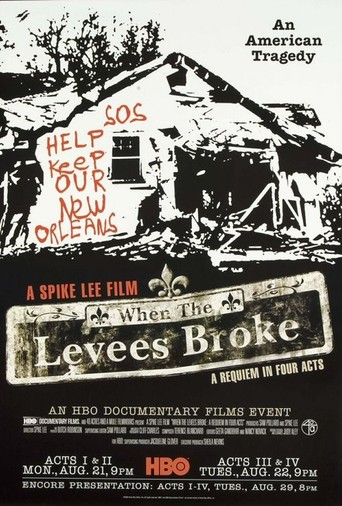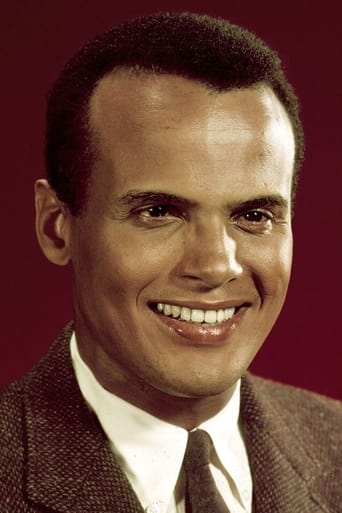When the Levees Broke: A Requiem in Four Acts (2006)
In August 2005, the American city of New Orleans was struck by the powerful Hurricane Katrina. Although the storm was damaging by itself, that was not the true disaster. That happened when the city's flooding safeguards like levees failed and put most of the city, which is largely below sea level, underwater. This film covers that disastrous series of events that devastated the city and its people. Furthermore, the gross incompetence of the various governments and the powerful from the local to the federal level is examined to show how the poor and underprivileged of New Orleans were mistreated in this grand calamity and still ignored today.
Watch Trailer
Cast


Reviews
I'll tell you why so serious
It is neither dumb nor smart enough to be fun, and spends way too much time with its boring human characters.
There's no way I can possibly love it entirely but I just think its ridiculously bad, but enjoyable at the same time.
The film never slows down or bores, plunging from one harrowing sequence to the next.
Yes, Spike Lee has an agenda. So what? So does every documentarian. No one who has an ounce of humanity can deny that what happened in the aftermath of Hurricane Katrina was a failure of grotesque proportions. We can get food and water to people in Southeast Asia in two days, but it took five days for the same government to get food and water to our fellow citizens!?! That is deplorable, and it makes the mayor, the governor, the president and everyone in government look bad. What makes them look worse is that an actor, Sean Penn, is able to do more -- and do more in a timely manner -- than anybody supposedly in power. What I appreciated most were the stories of those whose faith saw them through this catastrophe. I watched this during Holy Week, and that amazing rendition of "The Old Rugged Cross" stayed with me for days and will likely echo in me for weeks to come.
#1 - The residents of New Orleans were and are still being repeatedly f***ed at every level of government in the aftermath of Hurricane Katrina.#2 - Spike Lee is one of the most, if not THE most original American filmmaker of the last 25 years. His command of visual language is stunning.By drawing from a large sampling of people from across the city and at numerous levels of government, Spike keeps his picture balanced. This evenhandedness actually serves to focus the message even more, as disparate people reinforce each others arguments, and forge a cohesive tale of what happened, how it happened, what went wrong, and who is to blame.Quite possibly the best documentary (period.) in 20 years.
Spike Lee tells the story of Hurricane Katrina's toll on the people of New Orleans in this long film made for an HBO miniseries, a highly detailed account of the disaster, its antecedents and its continuing impact on the survivors. Lee has utilized a vast trove of archival footage, shot much new material, and interviewed around 100 individuals from victims to political leaders and engineers. The version that aired on television consists of four "acts," spanning 255 minutes cumulative running time; the DVD adds an "act V Next Movement" another hour or so composed exclusively of further material from the interviews.The story, of course, is familiar to all of us in both its broad outline and many of the details presented here. But Lee succeeds in elaborating upon the suffering, frustrations, and often half concealed truths of the story in a manner that far exceeds what came to us through the conventional media, with its usual foreshortened reportage. It is a monumental accomplishment, a journalistic tour de force that is unparalleled in its depth and poignancy.We do learn new things. In one glaring instance, we are told that armed vigilantes formed human barriers to prevent the exodus of those departing flooded areas into a drier, safer place. We see evidence at every turn of the pathetically inadequate responses of local, state and federal government. In particular we get a first hand look at the absurdity of FEMA efforts, especially the horrid trailers that usually have been delivered too late, and, even then, are too often unfit to live in.We get a fuller picture than before of the flimsiness of the barriers to water surge erected by the Army Corps of Engineers: silly, thin little walls planted with insufficient depth, virtually begging to be knocked down, where instead broad earthen levees were needed. We are confronted by the deep pain of people returning to inspect houses that are beyond repair, filled with ugly piles of goods where once orderly rooms of furniture and other belongings had their place. The insides of these places - piled full of gruesome messes of detritus that once were articles of furniture, appliances and beloved possessions, as if some hostile giant had savagely shaken the places while holding them under water look horridly alike.The story goes agonizingly along. And we come away wondering whether a disaster of this magnitude, had it occurred in a community not so heavily composed of underclass folks, primarily people of color, would have evoked a swifter, more supportive, and more effective response by government agencies and private insurers.Many among those interviewed have profoundly troubling stories to tell and several tales of courage and generosity. Among the most memorable voices to me were: civil engineering professor Robert Bea; composer Terence Blanchard; historian Douglas Brinkley; trial attorney Joseph Bruno; state medical examiner Louis Cataldie; Eddie Compass, former N.O. police chief; Calvin Mackie, Tulane engineering professor, speaking of the deaths of his parents seemingly brought on by the catastrophe; Wynton Marsalis; Mother Audrey Mason, who tells Barbara Bush a thing or two; Times-Picayune City Editor David Meeks; CNN reporter Soledad O'Brien; Sean Penn, recounting his personal efforts to save people stranded in their homes; actor Wendell Pierce; local radio commentator Garland Robinette; and minister Elder William Walker, Jr.Among other displaced survivors not so well known, some of the most arresting in their responses are Terence Blanchard's mother, Wilhelmina; Phyllis Montana LeBlanc, who recites her harsh poem about the event; Judith Morgan and Cheryl Livaudais, who deliver a shrill duet of nonstop slashing criticism of the whole post-storm relief effort; Kimberly Polk, who lost her 5 year old daughter; Michael Seelig I could go on and on Lee's focus is selective. He touches lightly on the technical and engineering issues. He offers no real analysis of the political and bureaucratic problems hampering relief efforts. He doesn't follow the story of the health care crisis or allegations of euthanasia in several cases. He doesn't follow people exiled to other cities and states to see first hand how they are faring.Lee also doesn't mention the jockeying of developers, lobbyists and politicians scheming to make money off the rebuilding process. The material Lee uses to highlight the conduct of civic leaders is closely cropped, no more comprehensive than the best news shows offered at the time. No, Lee's lens remains for the most part fixed on the suffering of the people black, white, and mostly poor.The quality of the photography is highly variable, as you expect when footage is extracted from many sources. But the editing is generally very good. The music is a mixed bag. There are famous tunes, like Fats Domino's "Walking to New Orleans" and the traditional "St. James Infirmary" sung, surprisingly, by Marsalis. There's footage of a wonderful funeral band processing along the street in "act IV." Theme music that reoccurs throughout the entire series is from the recent movie, "Inside Man," composed by New Orleans' Terence Blanchard, the same man already mentioned among notable interviewees. Blanchard has worked with Spike Lee for years, doing the music on most of Lee 's film projects. His score in this instance is entirely fitting: it is elegiac, funereal, slowly paced, often rendered with a spare unaccompanied piano. But for some obscure reason Lee's sound mixer often decides to suddenly ratchet up the volume to the point that it can drown out what interviewees are saying and even feel enervating and painful to the ear. So one must sit with remote control in hand, constantly on the alert to turn the volume down, then later back up, to contend with this bothersome phenomenon.Despite its selective focus and the sound problems, overall this unique production is one that no informed citizen will want to miss. My grades: 8/10 (B+) (DVD seen on 02/03/07)
Spike Lee is certainly not correct about levees being blown,but the truth is even worse.He is certainly nearer to the truth than people who blame "the force of the hurricane".As one who rode out both Katrina and Hurricane Betsy in the same house in Gentilly,it was obvious at the time that Katrina was no worse.The lake levees,which were properly built,though exposed to the full force of the storm,came through unscathed.What collapsed and flooded the main part of the city west of the Industrial Canal were those worthless,cracker box,stage-prop "flood walls" along the drainage canals that folded up and collapsed like cheap card tables the minute the water rose.Besides the Corps of Engineers,we can blame former Mayor "Slimy Sidney" Barthelemy"The Man Who Murdered A City".He deliberately forced out the veteran engineers of the Sewage & Water Board,so that no one would object to those worthless (but profitable) frauds.AND he had the valuable assistance of the alleged "newspaper",the Times Picayune which covered up his criminality. The incompetent stooges that Barthelemy replaced the experienced engineers with not only approved those worthless flood walls that the old engineers knew were disasters waiting to happen,but, still infesting the Sewage & Water Board to this day,insanely dredged the drainage canals in such a way as to remove what little foundations those flood walls had.The 17th St. Canal shows this graphically.This sits astride the parish line.Jefferson Parish engineers refused to allow this lunatic dredging on THEIR side of the canal, which is why only the Orleans side collapsed.A year before Katrina, people living along the drainage canals complained of salt water seeping into their yards, killing plants.To a COMPETENT,HONEST engineer this a clear sign that something was dangerously wrong with the levee foundations.But the Barthelemy "engineers" swept it under the rug,telling people that they were "imagining things".And as for blaming those who wouldn't evacuate,If one thing was proved, it is that evacuating a city this size IS NOT PRACTICAL.New Orleans could and should have been an impregnable fortress against hurricanes.The vast bulk of the misery caused by Barthelemy's Flood was the destruction of the homes,and LIVES of the "survivors",who now have to live,or rather EXIST in this horror.The empty city was picked clean by looters despite the presence of thousands of police and National Guard,which shows that it is the PEOPLE who are the real crime deterrents.Telling people,"Get out, let the hurricane and the looters destroy your homes and businesses,and we will give you sardine can trailers to live in" is typical of the garbage we hear from the government.





